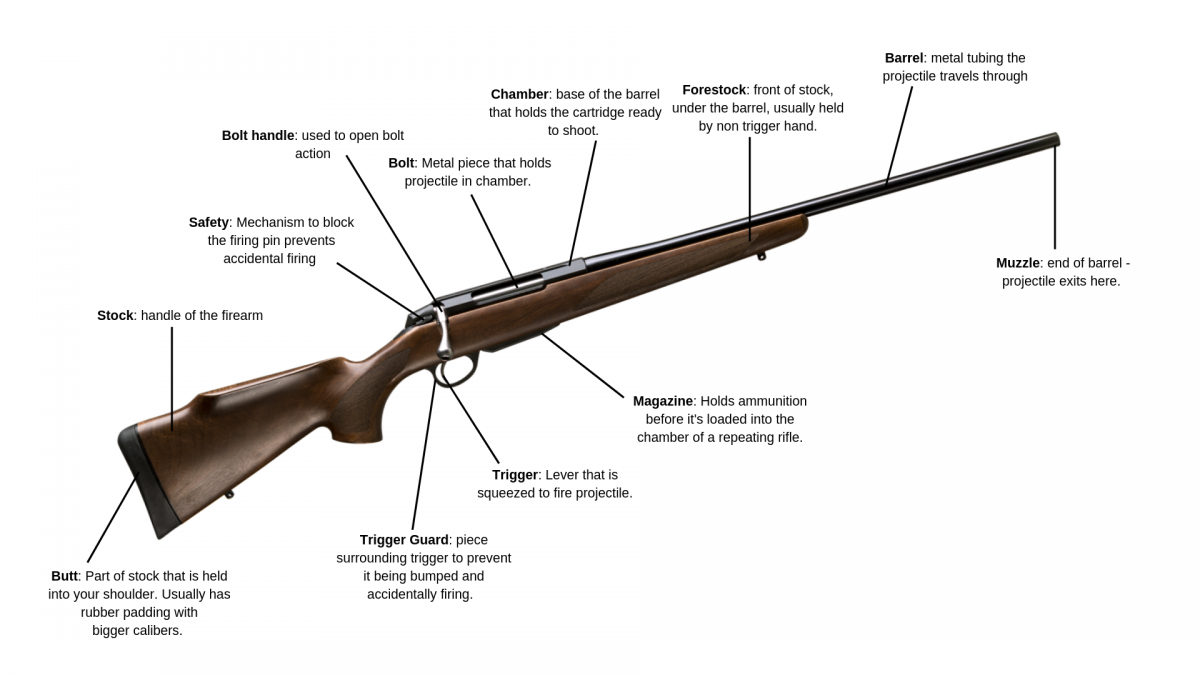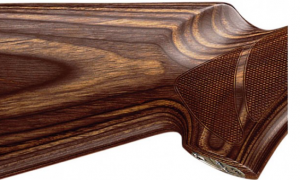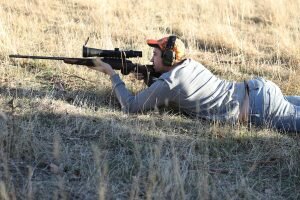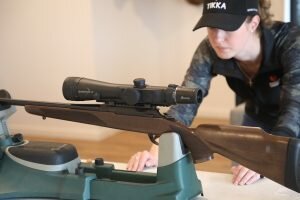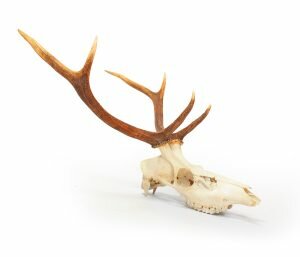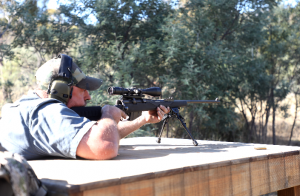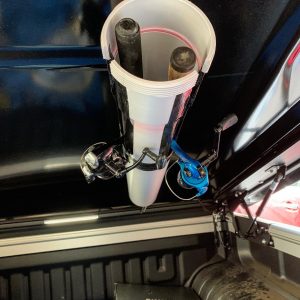Are you new to hunting? If you didn’t grow up around hunting and firearms, learning to hunt can sometimes feel a little overwhelming. There are lots of moving parts to a rifle but how do all the parts work together? What is the difference between hollow point ammunition and a full metal jacket? This hunter education introduction explains the action, ammunition and calibers of a bolt action rifle and how they all work together to determine effective killing range.
What is a rifle?
At its most basic, a rifle is a type of firearm with a long barrel capable of shooting accurately over long distances.
However, if you want to learn to hunt safely with a rifle, you need to understand more than just a basic definition. You need to understand all the parts that make up a rifle, the right ammunition to use, and how it all works together.
The basic parts of a rifle
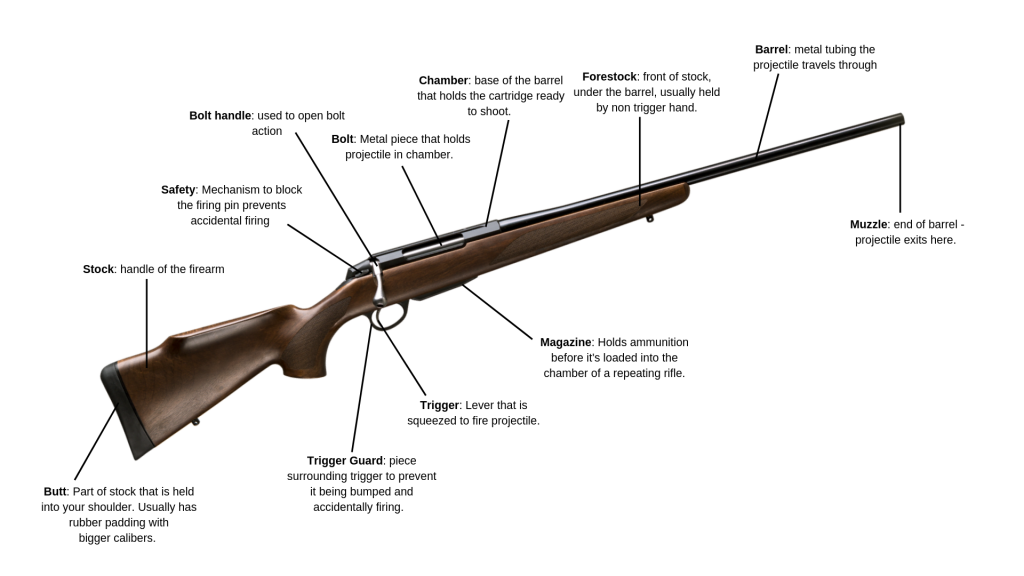 Rifles haven’t changed much since they were first invented. Sure, technology might have made some cool improvements to modern firearms, including the introduction of lightweight materials, and the terminology might have changed slightly, but all modern firearms have three basic groups of parts: action, stock and barrel.
Rifles haven’t changed much since they were first invented. Sure, technology might have made some cool improvements to modern firearms, including the introduction of lightweight materials, and the terminology might have changed slightly, but all modern firearms have three basic groups of parts: action, stock and barrel.
The action
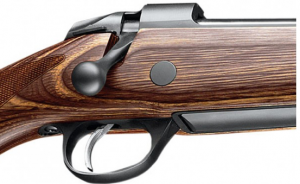
The action is the heart of your rifle and includes the moving parts that load, fire and eject the bullets. A bolt action rifle uses a bolt that acts as the door to your rifle and a lock for your breech. The action on many of the new rifles will often have rails to mount a scope.
The stock
The stock acts like a handle and is generally composed of wood or a synthetic material.
The barrel
The barrel is the long metal tube that the bullet travels through. During the mid-1600s, firearm manufacturers started to rifle the inside of the barrel. Rifling is the process of cutting twists into the bore of the barrel, which makes the bullet spin and significantly improves accuracy (commonly known as the twist rate).
There are some other internal parts not visible on the model above. These include:
The bore
The internal part of the barrel that the bullet travels through. The diameter of the bore determines the calibre of the rifle (however, for most ammunition, the calibre also refers to the outside diameter of the bullet used).
The breech
The rear end of the barrel.
The firing pin
A metal pin that strikes the primer on the bullet, causing ignition.
The receiver
This is the metal housing that holds the working parts of the action.
The lowdown on rifle ammunition
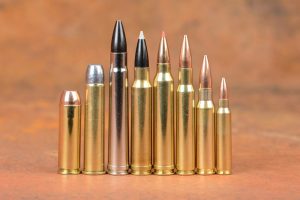 Rifles use a cartridge containing a single projectile, also called a bullet, which comes in various sizes and weights. Rifle ammunition is either centre-fire (the firing pin hits the middle of the case) or rim-fire (the firing pin hits the edge of the case). Most centre-fire ammunition is reloadable, however, rimfire ammunition is not normally reloaded. This is because rimfire ammunition is generally limited to low-pressure loads, and would also require you to rebuild the casing. This technique is beyond the skills of most hunters and shooters.
Rifles use a cartridge containing a single projectile, also called a bullet, which comes in various sizes and weights. Rifle ammunition is either centre-fire (the firing pin hits the middle of the case) or rim-fire (the firing pin hits the edge of the case). Most centre-fire ammunition is reloadable, however, rimfire ammunition is not normally reloaded. This is because rimfire ammunition is generally limited to low-pressure loads, and would also require you to rebuild the casing. This technique is beyond the skills of most hunters and shooters.
All rifle ammunition is made up of these four basic components:
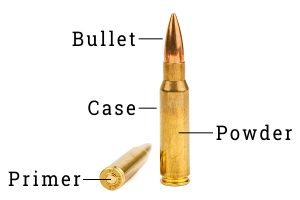
Case
Typically made of brass, copper, or steel (though other materials can also be used), the case acts as a container, holding all the other components together.
Primer
Located in the base of the case, the primer contains a small, impact sensitive compound that, when struck by the firing pin, ignites the gunpowder and expels the projectile.
Propellant (gunpowder)
A chemical substance that consists of around 75 percent potassium nitrate (saltpeter), 15 percent charcoal, and 10 percent sulfur. Gunpowder burns rapidly when ignited, expanding to a gas that, together with the primer, forces the projectile down the barrel.
Projectile (bullet)
This is the tip of the spear (so to speak), the part on the end of a cartridge that is expelled out of the barrel and that hits the target. Projectiles are generally constructed of a solid lead core covered in a copper jacket and come in several common variants, including:
Full metal jacket (FMJ) – a lead bullet fully covered from base to tip in copper (which can either be pointed or rounded). FMJs are cheap to produce and accurate over long distances, which makes them ideal ammunition for target shooting. FMJs do have a tendency to pinhole living targets, exiting the body leaving only a very small wound, so care should be taken if you are considering them for hunting.
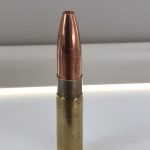 Hollow point – these bullets feature a hole at the tip that is designed to force the bullet to expand on impact and cause a bigger (more fatal) wound. For this reason, they are a good choice for hunting. However, the hole also creates drag, which slows the bullet and can limit the overall accuracy for longer distance shooting. Testing your rifle and bullet choice at various distances is important to gain confidence with the tools.
Hollow point – these bullets feature a hole at the tip that is designed to force the bullet to expand on impact and cause a bigger (more fatal) wound. For this reason, they are a good choice for hunting. However, the hole also creates drag, which slows the bullet and can limit the overall accuracy for longer distance shooting. Testing your rifle and bullet choice at various distances is important to gain confidence with the tools.
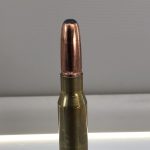 Soft point – combines the long range accuracy of a FMJ with the terminal ballistics of a hollow point by leaving a small, soft point of the lead core protruding from the front of the round. A favourite round for big bore hunters with larger or dangerous game in their sights.
Soft point – combines the long range accuracy of a FMJ with the terminal ballistics of a hollow point by leaving a small, soft point of the lead core protruding from the front of the round. A favourite round for big bore hunters with larger or dangerous game in their sights.
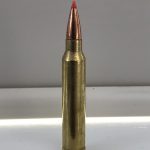 Ballistic tip – this is basically the upgrade to the soft point, and combines the benefits of the FMJ, the hollow tip and the soft point and then improves it. The hole at the tip is exaggerated, like the hollow point, which allows the bullet to expand on impact. However, the hole is covered by a cone-shaped piece of plastic that gives the aerodynamic benefits of a FMJ, giving it greater accuracy over longer distances. There is, however, a lot of conjecture around this bullet type, possibly due to the cost per bullet. Many people wonder whether it is really worth it, when they can cost 40 – 60 percent more than hollow or soft points.
Ballistic tip – this is basically the upgrade to the soft point, and combines the benefits of the FMJ, the hollow tip and the soft point and then improves it. The hole at the tip is exaggerated, like the hollow point, which allows the bullet to expand on impact. However, the hole is covered by a cone-shaped piece of plastic that gives the aerodynamic benefits of a FMJ, giving it greater accuracy over longer distances. There is, however, a lot of conjecture around this bullet type, possibly due to the cost per bullet. Many people wonder whether it is really worth it, when they can cost 40 – 60 percent more than hollow or soft points.
Whichever type of ammunition you choose, it is vital that you only ever use the correct ammunition for your firearm, as getting it wrong can cause an explosion that won’t just ruin your firearm, it could also injure or possibly kill you or someone standing close by.
To match the correct ammunition to your rifle, check the specific calibre on the side of the barrel and match this exactly to the information on the lid of the ammunition box. Some calibres share the same bullet diameter but use distinctly different cartridges, and are not at all interchangeable.
For example, a .300 Blackout and a .300 Win Mag share the same diameter bullet but the cartridge on a .300 Win Mag is twice as long as the .300 Blackout.
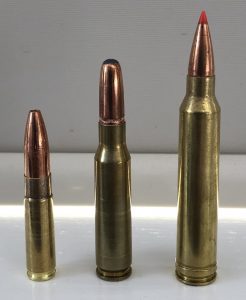
Similarly, it might not sound like there’s a lot of difference between a .270 Weatherby Magnum and a .270 Winchester but the two are made from completely different cartridges.
This is especially important if you own rifles in very similar calibres or are hunting with a friend who has a similar calibre. When it comes to firearms and ammunition, a simple mistake can have catastrophic consequences.
To help ensure you don’t mix up your ammunition, always buy the correct ammunition for your rifle and store it in the manufacturer’s box or have it clearly marked. If you reload your own ammunition, always store it in clearly marked boxes or containers.
How a rifle works
This might seem like really basic information but for people just learning to hunt or first undertaking their hunter education course, knowing how a rifle all works together can seem a little alien.
To put it simply, once you have acquired your target and are ready to fire your rifle, load a cartridge into the chamber. This is done by pulling the action (bolt) back. This simultaneously ejects any spent cartridge and moves a fresh cartridge from the magazine to the read position. Pushing the action forward inserts the cartridge into the chamber. The final movement of the bolt to close the action pushes the firing pin back and holds it in place under spring tension.
The rifle is now loaded and no longer safe.
To fire the rifle, point the rifle in a safe direction (generally at the target) and gently squeeze the trigger. This releases the firing pin, setting off a chain reaction.
The firing pin strikes the primer in the base of the cartridge, causing it to explode. The spark from the explosion ignites the propellant, which burns and converts to gas. The gas expands and forces the bullet out of the cartridge and down the barrel of the rifle. The rifling (the spiral cuts or grooves inside the barrel) causes the bullet to spin, which makes it travel faster. The combination of the speed and the escaping gases produce the loud bang and percussion that accompanies the firing of a rifle.
Safety mechanisms
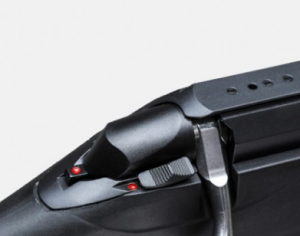 Almost all rifles have a safety mechanism that blocks the action and prevents it from shooting until the safety is switched off. On a bolt action rifle, this is usually a pivot safety (a lever or tab that blocks the trigger or the firing pin) or a slide safety (a sliding bar that slides to block the firing action). As the name suggests, safeties are designed to prevent the rifle from accidentally firing and should always be engaged until you are ready to fire.
Almost all rifles have a safety mechanism that blocks the action and prevents it from shooting until the safety is switched off. On a bolt action rifle, this is usually a pivot safety (a lever or tab that blocks the trigger or the firing pin) or a slide safety (a sliding bar that slides to block the firing action). As the name suggests, safeties are designed to prevent the rifle from accidentally firing and should always be engaged until you are ready to fire.
However, like any mechanical device, a safety can fail for a variety of reasons including wear and tear, or debris. It can also be accidentally bumped from the safe position while being handled or by catching on clothing or foreign objects. For that reason, a safety should never be your only line of defence against accidental firing but just an additional measure that you employ to hunt safely. In fact, the safest measure is to not load your rifle until you are completely sure of your target and ready to fire.
Magazines
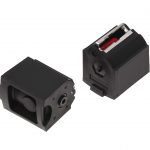 A magazine is a device used to store ammunition. When you work the action on your rifle, a simple spring and follower device moves the cartridge from magazine and pushes it up into the chamber, ready to be fired. Magazines can be detachable or fixed and will have a limit to the amount of ammunition each one can store. There may be restrictions on the size of the magazine depending on regulations or law. If in doubt, your local gun store should know what these limits are.
A magazine is a device used to store ammunition. When you work the action on your rifle, a simple spring and follower device moves the cartridge from magazine and pushes it up into the chamber, ready to be fired. Magazines can be detachable or fixed and will have a limit to the amount of ammunition each one can store. There may be restrictions on the size of the magazine depending on regulations or law. If in doubt, your local gun store should know what these limits are.
Sights
In simple terms, a sight is a device that lines the muzzle up with your eye so you can hit the target. Rifle sights can either be open, aperture (peep) or telescopic (scope).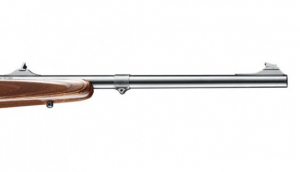 Open sight – one of the simplest and least expensive sights available. It combines a bead or post as the front sight with a notched or ridged rear sight.
Open sight – one of the simplest and least expensive sights available. It combines a bead or post as the front sight with a notched or ridged rear sight.
Aperture – similar to the open sight, the aperture has a bead or post as the front sight. But instead of a notch at the rear, it uses a small round hole at the back.

Telescopic – known as a scope, this is essentially a small telescope attached to the front of your rifle that gathers light to brighten the image and magnifies the target. Because of its heightened accuracy, a scope is more commonly used for hunting, particularly over longer distances.
Calibres
A rifle’s calibre describes the size of the bore. It is expressed in one-hundredths of an inch or mm (Imperial vs Metric) and measures the diameter of the bore from land to opposite land. For instance, the diameter between the lands on a .308 calibre rifle bore would measure 308/1000ths of an inch. Calibre can also mean the diameter of the bullet, like 7mm.
Common rifle calibres include .45, .458, .44, 10mm, .357, .38, 9mm, .30, .30-06, .308, .32, 7.62mm, .270, 7mm, .22, .223, .243, 5.56mm, and 6mm. A few of these are also calibres of handguns.
Sometimes, calibre designations have a second number that doesn’t relate to the diameter of the bore or the bullet. In fact, the second numbers may mean something totally different depending on the type of bullet. For instance, the .30-30 is a .30 calibre cartridge but the second number refers to the 30 grains of powder the bullet used to take. Similarly, a .30-06 is a .30 calibre cartridge but the 06 refers to the date (1906) that it became the official ammunition of the US military.
The most important thing to remember when you first start out hunting is that rifles are designed to only take a specific type of ammunition. It is vital that you match the ammunition to the data stamp on your rifle. If in doubt, take your rifle into your local gun shop and ask for the correct rounds for your rifle.
Effective killing range
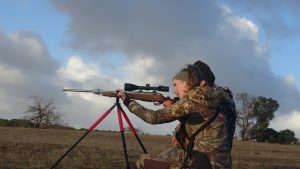
An ethical hunter should have a good idea of the maximum range their rifle’s ammunition is capable of reaching for an effective kill so they do not leave or lose an injured animal. The effective killing range of ammunition can vary greatly for each and every projectile. Often, the manufacturer will indicate the effective range of a bullet on the packet.
When you have been hunting for a while, you will hear a lot of chatter about Ballistic Coefficients (BC) but when you are just learning to hunt, it can seem a really foreign concept. In basic terms, this is the ability for the bullet to resist drag over distance. The better the BC, the faster the bullet flies down range with less drop over distance, which equates to more energy delivered to the target. BC really comes into play at distances beyond 150m. This detail very quickly gets into range based shooting science, which is beyond the scope of this article.
What is I Am Hunter?
I Am Hunter wants to change the way hunting is perceived and to change the conversation from a negative one driven by anti-hunters to a positive one led by hunters.
Our goal is to help hunters become positive role models and ambassadors for hunting, while simultaneously helping non-hunters understand why hunting is important.
You can become a supporter and help us achieve our goal and spread a positive message about hunting with the wider community.
Related content
Our other channels
Get our newsletter
Get our free monthly newsletter direct to your inbox
Listen on iTunes
Listen to our podcast on iTunes.
TV series
Watch I Am Hunter episodes on My Outdoor TV (MOTV)

